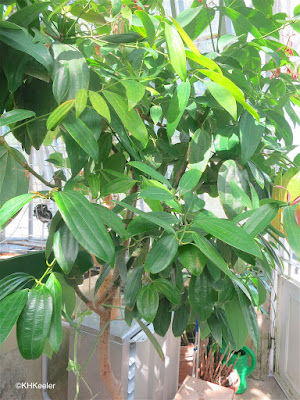 |
| Cinnamomum, source of cinnamon. New leaves are red. |
The trees are truly tropical and do not grow in Europe or the continental United States. Their history is complicated by the fact that all 270 or so species in the genus have aromatic bark and can be used as cinnamon. Two Cinnamomum species in particular have been the source of the spice for centuries, Cinnamomum verum from Sri Lanka, Ceylon cinnamon, and Cinnamomum cassia from China, cassia or cassia cinnamon. Both were imported to Europe in classical times. For example, in 64 CE Dioscorides wrote in his Materia Medica, "There are many kinds of cinnamon...choose that which is new, black in colour, inclining to an ash colour like that of wine, with slender smooth shoots, full of lasting knots, especially fragrant" 1-13 (p. 18) and goes on to describe other kinds.
 |
| leaves of Cinnamomum |
 |
| Cinnamomum in a conservatory |
However, there is a problematic confusion with the name cassia. There is a plant genus Cassia (examples) with some 700 species. These cassias are tropical and subtropical trees and shrubs in the pea family (Fabaceae), some with spectacular, usually yellow, flowers, frequently grown as ornamentals. Most have compound leaves, compared to the big oval leaves of the cinnamons. Golden shower tree, Cassia fistula, is one of the most familiar (links). They are often called cassia and sold by nurseries as cassias. They do not produce cinnamon and some writers, whether writing about cinnamon or flowering trees, don't realized they are different. Check details for yourself.
 |
| Cassia, the legume, not a source of cinnamon. Flowers of golden shower tree, Cassia fistula |
The name cassia is Greek. My Greek dictionary says it was the name for an inferior form of cinnamon. The botanical books say cassia was the historic Greek name for a leguminous plant, that is, in the genus Cassia. The genus Cassia and their close relatives in the genus Senna can be aromatic and have been (some still are) used medicinally. In 64 CE, Dioscorides recognized both Cassia (the legume) (the entry before cinnamon) and the cinnamons. So I conclude the confusion--verbal and possibly medicinal--of Ceylon cinnamon, cassia cinnamon, and the Cassia legumes goes back to ancient times.
Harvested in Asia and transported to Europe, cinnamon was one of the most valuable spices of antiquity. It was frequently worth its weight, or more, in gold. This value motivated the Arab traders who brought it to conceal its origin. (Or perhaps they didn't know). The Greek Herodotus, writing The Histories in 440 BCE, wrote of cassia and cinnamon (complete quote because his style is well, distinctive):
110.... cassia is obtained as follows:-- they bind up in cows'-hide and other kinds of skins all their body and their face except only the eyes, and then go to get the cassia. This grows in a pool not very deep, and round the pool and in it lodge, it seems, winged beasts nearly resembling bats, and they squeak horribly and are courageous in fight. These they must keep off from their eyes, and so cut the cassia. (Book 3, 110)
111. Cinnamon they collect in a yet more marvellous manner than this: for where it grows and what land produces it they are not able to tell, except only that some say (and it is a probable account) that it grows in those regions where Dionysos was brought up; and they say that large birds carry those dried sticks which we have learnt from the Phenicians to call cinnamon, carry them, I say, to nests which are made of clay and stuck on to precipitous sides of mountains, which man can find no means of scaling. With regard to this then the Arabians practise the following contrivance:-- they divide up the limbs of the oxen and asses that die and of their other beasts of burden, into pieces as large as convenient, and convey them to these places, and when they have laid them down not far from the nests, they withdraw to a distance from them: and the birds fly down and carry the limbs of the beasts of burden off to their nests; and these are not able to bear them, but break down and fall to the earth; and the men come up to them and collect the cinnamon. Thus cinnamon is collected and comes from this nation to the other countries of the world. (Book 3, 111).
In reality, for both cinnamons, workers, then and now, stripped the bark off the trees, which were often trimmed into shrubs to facilitate harvest. The fresh bark was left to rot for a day, which made it easier to remove the outer bark. The inner bark was traditionally dried in the sun and then in shade, and formed, if it didn't roll spontaneously, into the quills that are our cinnamon sticks. It remains a labor-intensive process, keeping the price of cinnamon high. (We don't usually need very much but cinnamon currently costs about $1 an ounce, which, as $16 per pound, is more than most foods.) |
| Cinnamon sticks, probably cassia cinnamon. |
Comments and corrections welcome.
References
Herodotus. The Histories. Book 3 110 and 111. 440 BC. Internet Sacred Texts Archive. sacredtexts. com link Accessed 4/20/20.
No auhtor given. 1977. A Lexicon. Abridged from Liddell and Scott's Greek-English Lexicon. Oxford University Press, Oxford.
Osbaldkeston, A. Dioscorides. De Materia Medica. Updated edition of Goodyer's English translation, 1655. 2000. online at Internet Archive link Accessed 4/20/20.
Swahn, J. O. 1991. The Lore of Spices. Crescent Booka, New York.
Kathy Keeler, A Wandering Botanist
More at awanderingbotanist.com
Thank you! Good read this morning.
ReplyDeleteVery good read! Thank you! Good nite from Debbie stuck in woodspring in Rockledge,fl saturday 11:48 pm please 🙏 for me and God bless my home demolished by rebuild fl.over 6 years ago.ty!God bless America 🇺🇸 🙏
ReplyDelete